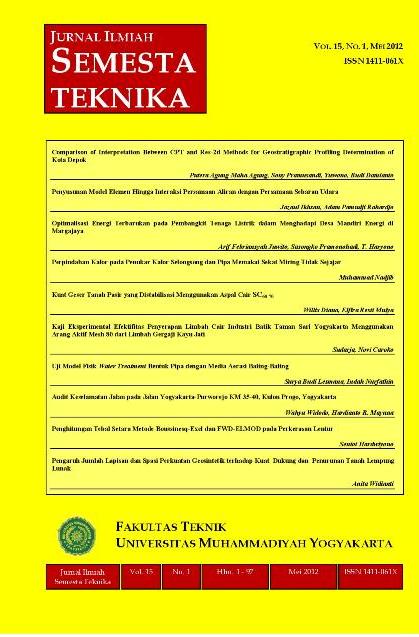Perpindahan Kalor pada Penukar Kalor Selongsong dan Pipa Memakai Sekat Miring Tidak Sejajar
DOI:
https://doi.org/10.18196/st.v15i1.441Abstract
Generally speaking, baffle installation of a shell-and-tube heat exchanger is in straight-standing with respect to shell axis. A common problem of this arrangement is that there will be found a stagnant fluid condition in the death-zone. The impact is the heat transfer coefficient could not reach an optimum value. Based on baffle configuration, the death-zone effect can be minimized by installing an un-parallel tilted baffle. The purpose of this research is to investigate the effect of using non-parallel tilted baffle on heat transfer coefficient. The heat exchanger model was made with single pass fluids. Hot water is going through inside the tube bundles and cold water pass is in the shell. The baffle was installed in various angle of 0°, 15°, 30°, and 45° with respect to shell axis. The cold water flow rates were varied from 75 l/hr, 100 l/hr, 125 l/hr, 150 l/hr, 175 l/hr, to 200 l/hr. The hot water flow rate was fixed at 150 l/hr. Temperature of the hot and cold water at inlet and outlet was recorded by means of K type thermocouple and data logger. The data was then analyzed to obtain the convection heat transfer coefficient. The data were also used to determine the empirical correlation of Nusselt number and Reynolds number. The results indicate that baffle in angle 0° produce the highest convection heat transfer coefficient. Installing the baffle at tilted position is not significant in convection heat transfer coefficient. The empirical correlation of Nusselt number and Reynolds number is influenced by angle function of the baffle.
Downloads
Published
How to Cite
Issue
Section
License
Semesta Teknika is licensed under a Creative Commons Attribution 4.0 International License.
Authors who publish with this journal agree to the following terms:
- Authors retain copyright and grant the journal right of first publication with the work simultaneously licensed under a Creative Commons Attribution License that allows others to share the work with an acknowledgement of the work's authorship and initial publication in this journal.
- Authors are able to enter into separate, additional contractual arrangements for the non-exclusive distribution of the journal's published version of the work (e.g., post it to an institutional repository or publish it in a book), with an acknowledgement of its initial publication in this journal.
- Authors are permitted and encouraged to post their work online (e.g., in institutional repositories or on their website) prior to and during the submission process, as it can lead to productive exchanges, as well as earlier and greater citation of published work (See The Effect of Open Access).









